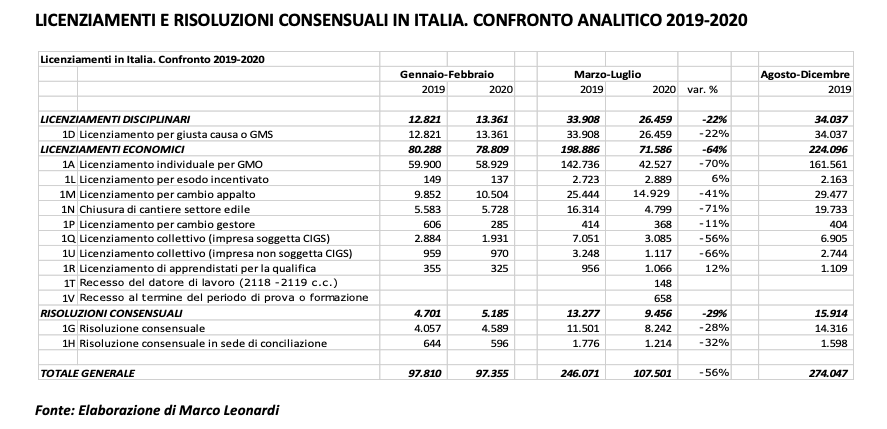Selective release of layoffs. Hypothesis and debate

The economist Leonardi's proposal is based on a priority release of industry and construction, sectors which, in addition to being sectors that have returned, on average, to normal, are still equipped with 52 weeks of their ordinary cig and do not need to resort to cig- covid. Giuliano Cazzola's opinion
One of the first problems that the Draghi government will have to solve is that of the blocking of layoffs. The trade unions have asked for a further extension (which, moreover, the former minister Nunzia Catalfo had promised without even providing for a deadline).
It is all too evident that at the end of March there will not be a traumatic end to the blockade, but it would be irresponsible not to set up an exit strategy that – as Mario Draghi said in his speech on trust – protects workers, but – we add – avoids leaving to companies that need to restructure and adapt their production volumes to the size of the markets, to bring fake jobs with them, which will remain such even after the end of the health emergency.
The round of ministers in key positions (such as Labor and the Mef ) is leading to a handover regarding the solutions that the offices were working on and which had circulated in the rumors at the level of ministerial Sherpas.
The hypotheses formulated by an advisor to Minister Roberto Gualtieri – the economist Marco Leonardi – had aroused particular interest, who had already dealt with delicate and important dossiers on behalf of the previous government and even before the executives of the XVII Legislature.
His is an articulated proposal that is based on a priority release of industry and construction, sectors that in addition to being sectors returned, on average, to normal, are still equipped with 52 weeks of their ordinary cig and do not need to resort to cig-covid. Then (in June / July) it would be possible to unblock the layoffs in the services and in the meantime extend the cig-covid until the end of 2021.
This should minimize the need to dismiss (as in other countries, if companies have the cig they avoid firing because dismissal is expensive anyway and, in most cases, it can be challenged through the courts) as happened during the crisis of the 2008-2009 when it was precisely the massive distribution of the cig in derogation to save, according to estimates at the time, at least 700 thousand jobs.
Leonardi then carries out an operation of intellectual honesty by denying the terrorist announcements of millions of jobs in danger if the ordinary discipline of individual and collective dismissal for staff reduction were restored (see the table that compares the redundancies occurred in 2019 with those of 2020, under the block regime).

As for the period from August to December, in 2019 there were 224,000 economic layoffs. Assuming for the period August-December 2020 a contraction of around 50-60% would lead to a further accumulation of about 120,000 "missing" layoffs.
In total, therefore, we could have arrived at the end of the year with a "reserve" (compared to the "physiology" of the labor market in recent years) of economic layoffs "blocked" around 200,000-250,000 units. A fact that it would be wrong to underestimate due to its gravity, but which could be manageable through the use of the cig and other social safety nets: a) a 2-month extension of the hose for those who finish it in the months of January-March with an argument that hiring is still slowing down.
It could be useful to relax the entry requirements in 2021 for young people many of whom have lost expired term contracts (even if the costs would be high); b) expansion contract: for those who are 5 years after retirement, all companies with more than 250 employees can pay 3 years of severance pay and the State adds 2 years of reel; it is the only generalized “company slide” that could be envisaged to avoid the dismissal of elderly workers and to encourage turnover.
During the course of 2021 – Leonardi remembers – the problem of the end of quota 100 must also be faced; in this regard, some reasonable hypotheses of exit have been estimated, but the more the company slides will work, the less it will be necessary to reassure people after the end of quota 100; c) boost to active policies by strengthening the relocation allowance; d) use of NGEU resources (which does not finance passive but only active policies) with the allocation of 3.5 billion for active policies (essentially for the relocation allowance) and 3 billion for the training of employed and unemployed. Regarding this last item, in recent days there was talk of an immediate commitment of 1.5 billion.
This is a machine translation from Italian language of a post published on Start Magazine at the URL https://www.startmag.it/economia/sblocco-selettivo-dei-licenziamenti-ipotesi-e-dibattito/ on Thu, 25 Feb 2021 09:05:03 +0000.
